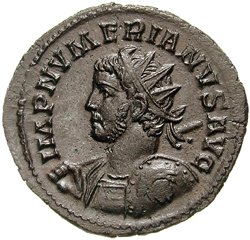
Diocletian, nicknamed Jovius, was Roman emperor from 284 until his abdication in 305. He was born Diocles to a family of low status in the Roman province of Dalmatia. Diocles rose through the ranks of the military early in his career, eventually becoming a cavalry commander for the army of Emperor Carus. After the deaths of Carus and his son Numerian on a campaign in Persia, Diocles was proclaimed emperor by the troops, taking the name Diocletianus. The title was also claimed by Carus's surviving son, Carinus, but Diocletian defeated him in the Battle of the Margus.

The 3rd century was the period from AD 201 to AD 300 (CCC) in accordance with the Julian calendar.
The 300s decade ran from January 1, 300, to December 31, 309.
The 310s decade ran from January 1, 310, to December 31, 319.
The 240s decade ran from January 1, 240, to December 31, 249.
The 290s decade ran from January 1, 290, to December 31, 299.
The 280's decade ran from January 1, 280, to December 31, 289.

Year 299 (CCXCIX) was a common year starting on Sunday of the Julian calendar. In the Roman Empire, it was known as the Year of the Consulship of Diocletian and Maximian. The denomination 299 for this year has been used since the early medieval period, when the Anno Domini calendar era became the prevalent method in Europe for naming years.

Year 384 (CCCLXXXIV) was a leap year starting on Monday of the Julian calendar. At the time, it was known as the Year of the Consulship of Ricomer and Clearchus. The denomination 384 for this year has been used since the early medieval period, when the Anno Domini calendar era became the prevalent method in Europe for giving names to years.
Year 283 (CCLXXXIII) was a common year starting on Monday of the Julian calendar. At the time, it was known as the Year of the Consulship of Carus and Carinus. The denomination 283 for this year has been used since the early medieval period, when the Anno Domini calendar era became the prevalent method in Europe for naming years.
Year 282 (CCLXXXII) was a common year starting on Sunday of the Julian calendar. At the time, it was known as the Year of the Consulship of Probus and Victorinus. The denomination 282 for this year has been used since the early medieval period, when the Anno Domini calendar era became the prevalent method in Europe for naming years.

Numerian was Roman emperor from 283 to 284 with his older brother Carinus. They were sons of Carus, a general raised to the office of praetorian prefect under Emperor Probus in 282.

Marcus Aurelius Carinus was Roman Emperor from 283 to 285. The eldest son of the Emperor Carus, he was first appointed Caesar in late 282, then given the title of Augustus in early 283, and made co-emperor of the western part of the Empire by his father. Official accounts of his character and career, which portray him as dissolute and incompetent, have been filtered through the propaganda of his successful opponent Diocletian.

Marcus Aurelius Carus was Roman emperor from 282 to 283. During his short reign, Carus fought the Germanic tribes and Sarmatians along the Danube frontier with success.

Marcus Aurelius Sabinus Julianus, known in English as Julian of Pannonia was a Roman usurper against Emperor Carinus or Maximian. It is possible that up to four usurpers with a similar name rebelled in a timeframe of a decade, but at least one of them is known by numismatic evidence.
The Prophetess is a late Jacobean era stage play, a tragicomedy written by John Fletcher and Philip Massinger. It was initially published in the first Beaumont and Fletcher folio of 1647.
Aper was a Roman citizen of the third century AD. First known to history as a professional soldier, he went on to serve as an acting provincial governor and finally became Praetorian prefect, under the Emperor Carus - in effect "vice principis". This rendered him hugely influential in the government of the empire - not excepting in matters of peace and war.
Titus Claudius Aurelius Aristobulus was a Roman soldier and politician who served as consul in 285 AD. He served two emperors, Carinus and Diocletian.
Pomponius Januarianus was an aristocrat who held a number of imperial appointments, most notably consul in AD 288.








